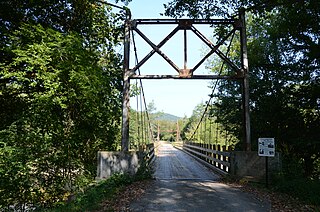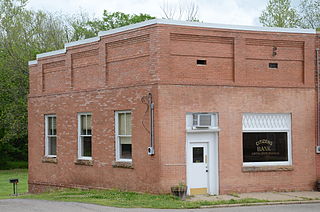
U.S. Route 64 is a U.S. highway running from Teec Nos Pos, Arizona east to Nags Head, North Carolina. In the U.S. state of Arkansas, the route runs 246.35 miles (396.46 km) from the Oklahoma border in Fort Smith east to the Tennessee border in Memphis. The route passes through several cities and towns, including Fort Smith, Clarksville, Russellville, Conway, Searcy, and West Memphis. US 64 runs parallel to Interstate 40 until Conway, when I-40 takes a more southerly route.

Highway 8 is an east–west state highway in Lower Arkansas. The route of 229.83 miles (369.88 km) runs from Oklahoma State Highway 63 (SH-63) at the Oklahoma state line east across the state to US Route 65 (US 65) south of Eudora.

The Cove Creek Bridge is a historic bridge, carrying Arkansas Highway 309 across Cove Creek, south of the hamlet of Corley, Arkansas in the Ozark-St. Francis National Forest. It is a two-span closed-spandrel masonry arch structure, with each span measuring 13 feet (4.0 m) and an overall structure length of 26 feet (7.9 m). It is built entirely out of stone, with a concrete and asphalt deck, and concrete barriers at the sides. It was built in 1936 with funding support from the Works Progress Administration.

U.S. Highway 71 is a U.S. highway that runs from Krotz Springs, LA to the Fort Frances–International Falls International Bridge at the Canadian border. In Arkansas, the highway runs from the Louisiana state line near Doddridge to the Missouri state line near Bella Vista. In Texarkana, the highway runs along State Line Avenue with US 59 and partially runs in Texas. Other areas served by the highway include Fort Smith and Northwest Arkansas.
The Sumner–White Dipping Vat is a historic concrete cattle dipping vat in Ashley County, Arkansas. It is located about four miles northeast of the intersection of U.S. Highway 82 and County Road 69, half a mile in the woods northeast of the Sumner-White Hunt Club. The vat is a concrete structure about 27 feet (8.2 m) long, 4 feet (1.2 m) wide, and 7 feet (2.1 m) deep. A U-shaped concrete structure, built about the same time, stands about 2 feet (0.61 m) from the vat, near where cattle would have exited the vat. It was probably built c. 1915, when a statewide program was initiated for the eradication of Texas tick fever. The facilities were likely used until the program came to an end in 1943.
The Gregory Dipping Vat is a historic cattle dipping facility at 122 Rogers Street on the outskirts of Lake Village, Arkansas. The vat is a concrete structure 27 feet (8.2 m) long, 4 feet (1.2 m) wide, and 7 feet (2.1 m) deep. It is located on a grassy lane off Rogers Road, in a wooded area not far from Bayou Macon, whose waters were used to fill it. The vat was built c. 1930 as part of a statewide program to eradicate Texas tick fever, which was at the time a serious problem affecting the area's cattle farmers. After the program was ended in 1943, the vat became a play area for local youth. It remains in good condition as a reminder of the economically important tick eradication program.

The Illinois River Bridge at Phillips Ford is a historic bridge in rural northern Washington County, Arkansas. It is a double-span closed-spandrel concrete arch bridge built in 1928 by the Luten Bridge Company, and it carries County Road 848 across the Illinois River in the Ozark National Forest south of U.S. Route 412 (US 412). The bridge's arches each span 81 feet (25 m), and the total structure length is 168 feet (51 m). The bridge uses Luten's patented method of reducing material in the bridge by the addition of metal rings to the spandrel walls.
The Dooley Dipping Vat is a historic former cattle dipping facility in Ouachita National Forest, southeast of Boles, Arkansas. It is located on a high bank of Countiss Creek east of County Road 925. It is a U-shaped concrete structure, oriented north–south with a concrete pad at southern (exit) end. The vat varies in depth between three and six feet, and is 48 inches (1,200 mm) wide at the entrance and 36 inches (910 mm) wide at the exit. It was built about 1920 as part of a state program to eradicate Texas tick fever from the state's cattle. The vat's name derives from James Dooley, who homesteaded a farm in the area.
The Square Rock Dipping Vat is a historic former cattle dipping facility in Ouachita National Forest, northeast of Waldron, Arkansas. It is located south of Square Rock Creek, off a forest road that runs south from County Road 94. It is a partially buried U-shaped concrete structure, with a concrete pad at one end, through which cattle were directed to dip them with chemical treatment for Texas tick fever. A barbed-wire holding pen of uncertain age stands nearby. It is believed to have been built about 1920, and was probably used until 1943, when the disease was determined to have been eradicated.
The CCC Company 741 Powder Magazine Historic District encompasses two structures built by Camp 741 of the Civilian Conservation Corps c. 1936. The camp, the first established in Arkansas, used these structures to store explosive materials used in road and bridge construction projects. The two structures have concrete bases and tops, and have walls of cut fieldstone and concrete. The main magazine is 8 by 16 feet, and the blasting cap storage building is about 10 by 10 feet. The main magazine is located a short way north of Forest Road 177M in Ouachita National Forest; the blasting cap storage building is about 113 metres (371 ft) to its northwest.
The Cogburn Dipping Vat is a historic former cattle dipping facility in Ouachita National Forest, west of Black Spring, Arkansas. It is located about 19 metres (62 ft) west of Forest Road 73 and south of a perennial stream. It is a U-shaped concrete structure, with a distinctive curved shape that matches the contours of the terrain, with a concrete pad at one end. The total length of the structure is about 13 metres (43 ft). It was built between 1930 and 1940 as part of a state program to eradicate Texas tick fever from the state's cattle. The vat's name derives from the Cogburn, who homesteaded a farm in the area, and probably built the vat to serve their needs and those of other nearby farmers.
The North Sylamore Creek Bridge is a historic bridge in the Ozark-St. Francis National Forest in northern Stone County, Arkansas. It is a Baltimore deck truss bridge, carrying Forest Service Road 1102 over North Sylamore Creek near the Gunner Pool Recreation Area. The bridge has two spans, each 110 feet (34 m) long, with a total structure length of 357 feet (109 m). It rests on concrete piers and abutments. The bridge was built in 1931, and is the only known example of this type of truss in the state.

The Sylamore Creek Bridge is a historic bridge in east central Stone County, Arkansas, just south of the Ozark-St. Francis National Forest. It carries County Road 283 across Sylamore Creek, a short way west of Arkansas Highway 9 and north of the Holiday Mountain Resort in Allison. It is a wire-cable suspension bridge, with steel towers mounted on concrete piers supporting four main cables that are anchored into concrete abutments. The bridge is 202 feet (62 m) long, with a deck width of 19 feet 6 inches (5.94 m) and a clearance height of 11 feet (3.4 m). Built in 1945, it is one of three known wire-cable bridges in the state.

The Jim Wright Farmstead Historic District encompasses a well-preserved early 20th-century farmstead in rural White County, Arkansas. The property is located on the south side of Arkansas Highway 258, east of its junction with Arkansas Highway 323, northwest of Bald Knob. It includes a Craftsman style single-story wood-frame farmhouse, with a wraparound porch supported by simple Doric columns, a simple wood-frame garage, and a single-story wood-frame house for tenant workers. It also includes remnants of the farmstead's first house and barn, silo, and a cattle dipping vat. This land was homesteaded in 1860 by the parents of Jim Wright, who is credited with construction of most of the farmstead's surviving features, which were built between 1924 and 1940.
The CCC Company 947 Powder Magazine is a historic powder magazine in the eastern part of Ouachita National Forest. It is located in southern Yell County, about 200 yards (180 m) down a slope north of a ridge running parallel to Forest Road 71. The structure is made of stone and concrete, and is 6 feet (1.8 m) square and 5 feet (1.5 m) high, with a flat concrete roof and floor. The entrance is on the southeast side. The building was erected about 1933 by a crew of the Civilian Conservation Corps, and was used to store explosive materials used in the construction of roads and bridges in the area.

The Pottsville Commercial Historic District encompasses a small cluster of turn-of-the-20th century commercial buildings on East Ash Street in Pottsville, Arkansas. It includes the 1887 former Falls and Sinclair store, and a block of three connected smaller brick buildings: the Pottsville Citizen's Bank (1913), and the Shue and Pryor stores, both built in the 1920s. Pottsville has historically served as a commercial supply and business district for the surrounding agricultural areas.

The Pottsville Dipping Vat is a historic cattle processing structure in Rankin Park, on East Ash Street in Pottsville, Arkansas. It consists of a U-shaped concrete structure, with an extended base at one end. The structure has a total length of 42 feet (13 m), and the vat is 2 feet (0.61 m) wide and 7 feet (2.1 m) deep. It was probably built about 1915, not long after the state began a program to eradicate Texas cattle fever from its livestock.

The Cove Creek Tributary Bridge is a historic bridge in rural Logan County, Arkansas. It is a two-span closed-spandrel stone arch bridge, carrying Arkansas Highway 309 across a tributary of Cove Creek north of Corley in Ozark-St. Francis National Forest. Each of its arches is 11 feet (3.4 m) long, and the structure is an overall 23 feet (7.0 m) in length. Concrete barriers form the sides of the bridge on either side of the roadway. The bridge was built in 1936 under the auspices of the Arkansas Highway Commission.
The Liberty Schoolhouse, also known as the Mt. Grove School, is a historic schoolhouse in a remote part of Ozark-St. Francis National Forest in Logan County, Arkansas. It is east of Corley, Arkansas, near the junction of Valentine Spring and Copper Spring Roads. It is a single-story vernacular wood-frame structure, with a gabled roof, weatherboard siding, and a foundation of concrete block piers. It was built in 1897, and was used by the community as both a school and church. It served as a school until 1944, and also hosted civic meetings and social events.
The Sasser Farm in Grady County, Georgia, near Cairo, Georgia, was listed on the National Register of Historic Places in 1983. It included nine contributing buildings.











